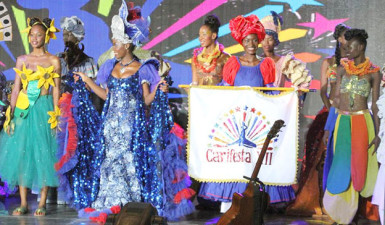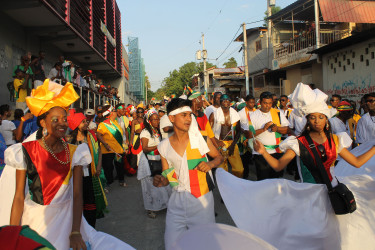President Martelly of Haiti speaking at the Grand Opening of Carifesta XII in Port Au Prince declared that there are two Haitis: “the Haiti that CNN talks about and the Haiti that we know.” The curtains will come down to close the Twelfth Caribbean Festival of the Arts this evening at the Kiosk – a version of the Greek styled open air auditorium – and by this time different faces of the host country will have uncovered themselves.
These might not necessarily be what the President meant, but they are quite contrasting images that emerged during the performances of the festival. These are perceptions of the country held by its Caricom neighbours; a stark reality that might have shocked the uninitiated, or confirmed some perceptions; a first-hand revelation of the arts of Haiti; and the popular response to the performing arts and to Carifesta as a whole.
One predominant feature of Carifesta XII has been the way it has been dominated by attention to the host country. There was quite a bit of curiosity when the festival was first staged in Suriname in 2003 (its second outing, after Cuba in 1979, in a non-English territory). But never before in any of the recent Carifestas has there been more interest in the host country. Carifesta XII has been more about Haiti than about the arts of the Caribbean. In a way this is reminiscent of the time when Suriname became hosts and the festival was held in an entirely different Caribbean culture. Geopolitics played a role in Caricom’s partnership with both Suriname and Haiti, as well as its embracing and support of Cuba. But politics, history, culture and solidarity, as well as the reasons for Haiti being so much in the news in our time have played a great role in the special place of the host country in 2015.
![]() When President Martelly spoke at the opening ceremony, he drew attention to himself as a populist President, in much the same way as Desi Bouterse did in Paramaribo in 2013. This populism is important because of what we will say later about the people’s response to Carifesta, but it is also relevant to the other factors mentioned above – the “two Haitis”, the perceptions and stereotyping, the revelations, and Caricom’s attitudes to Haiti.
When President Martelly spoke at the opening ceremony, he drew attention to himself as a populist President, in much the same way as Desi Bouterse did in Paramaribo in 2013. This populism is important because of what we will say later about the people’s response to Carifesta, but it is also relevant to the other factors mentioned above – the “two Haitis”, the perceptions and stereotyping, the revelations, and Caricom’s attitudes to Haiti.
Among the major reasons for this focus on the hosts, is one of the predominant attitudes to Haiti that obtain today in the Caricom countries. Haiti has been in the news and a great deal of goodwill has been extended to it. Caricom’s support for Haiti still resonates following the plight of Haitians living in the Dominican Republic, the country that occupies the larger eastern ‘half’ of the island historically known as Hispaniola. Caribbean solidarity is also still strong following earthquakes and natural disasters that have recently devastated the country. Added to that is the understanding in the face of Haiti’s turbulent politics following the departure of Jean Claude ‘Baby Doc’ Duvalier and the removal from office of the popularly elected President Aristide.


Apart from those, there is a strong recognition, spirit of commendation, and even reverence for the country that is regarded as having led the way and the foundations for liberation and independence in the Caribbean. The people of Saint Domingue (Haiti) hold the distinction of having freed themselves from French rule, staged the successful slave revolt and established the first independent state in the region. This was a topic discussed in the Caricom Symposia, particularly by writer Earl Lovelace and UWI Vice-Chancellor historian Hilary Beckles. Reparation was an issue, as well as the Haitian demand for a refund of the money they were forced to pay to French planters in 1820 as compensation for the loss of slaves and property in the 1803 Revolution. The hallowed place of Haiti in Caribbean history was lauded at the Symposia.
However, that was only a part of the perceptions of and attitudes to Haiti that obtain in the Region. The other is the country’s widespread reputation for poverty. It is regarded as the poorest country in the Region, and those perceptions would have been reinforced by much of what is to be seen around Port au Prince. Visible remnants of the ravages of the earthquake remain, and there is ample evidence of impoverishment in the crowded and undeveloped sections of the city. Garbage-strewn streets are made worse when it rains and rivers of polluted water flow forcefully through the thoroughfares, quickly flooding whole communities. Added to that is the petty crime on the streets, moving the authorities to put in place a strict regime of security and police presence everywhere Carifesta is held and its personnel have to travel.
After having been declared as the next host for Carifesta in 2013, it was for a long period accepted that the country was no longer able to fulfil its promise and that the festival would be suspended. However, at a fairly late stage Haiti announced that it would stage Carifesta in 2015 after all. Many were prompted to ask what moved the government to do this when they witnessed a general state of unreadiness in many areas of the festival. Most of the theatres and performance spaces were either in disrepair or insufficiently developed to support a large influx of visiting performers and the demands of Carifesta. The question was even raised about how much it must have cost the government to do it.
Stages were built, theatres were repaired, space made available, art galleries fashioned and brought into action with the work continuing even after the artists had arrived and were waiting for venues to be ready for performances. There were frequent changes and alterations to the programme, many of them stressful to participants.
However, notable work was in evidence to make Carifesta happen. Haiti had support from Jamaica from where two artistic directors – choreographer and dance maestra L’Antoinette Steines and cultural administrator Sidney Bartley were flown in to strengthen the planning and execution along with such Haitians as Ammelie Prophete. Caricom Secretariat officials including Hillary Brown and Rihanne DeHaas were also part of the leadership of the project.
The overall response to the situation and to the festival itself was therefore very noteworthy. Quite in keeping with one side of the perceptions of Haiti that prevail around the Caribbean, the host country proved itself resourceful and creative with a commendable commitment to Caricom. The determination that gave them the reputation as revolutionaries was in evidence as odds were overcome.
Above all, the popular response to Carifesta made an outstanding impact. It was a stated policy to involve the people of Haiti in Carifesta and in terms of public interest and audienceship they involved themselves. Here again were phenomena reminiscent of Suriname in 2003, although it can be said that what obtained in Haiti surpassed what happened there. In many instances programmes were changed and there must have been very short notice to the public that a particular show was taking place at a particular venue. Yet this did not appear to be a problem for the audience who turned up nevertheless. The attendance and interest of the educated middle class in the series of Symposia were strong.
However, the response of the popular audience made the more significant impact. There were some very popular venues that were activated. These include the Theatre Nationale which is located in an inner city area. Residents of the community obviously flocked to this venue and showed an appreciation for performance, although their bias towards more popular type entertainment was obvious. They proved a lively and robust audience steeped in the popular culture.
Further to that, there were public places that were brought into service as performance venues. These include Place Boyer, which is a large city park in which a stage was erected. This is an area that was always attended by large crowds, similar to the Kiosque, in the city centre, where the Opening Ceremony was held. This ceremony itself had popular appeal since it was a carnival-style procession that started out in the city streets and was led by Haitian masquerades and costumed depictions of the nation’s history and its dance theatre.
This dance theatre is of considerable interest and lived up to expectations of those who expected certain cultural exhibitions. What Haiti performed demonstrated the very powerful influence of African traditional retentions in the dance, the music, led by drumming, and the masquerade processions. The carnival styling that accompanies these dances had very robust and involved popular audience appeal.
Of note was the fairly limited number of countries that sent delegations to Carifesta. Guyana led the way with the largest contingent and participation in most of the artistic disciplines. Countries with grander reputations sent reduced numbers and performing acts. Trinidad and Tobago featured their leading and most celebrated fine artist Leroi Clarke, but a less heralded steel band and few others. Barbados made an impact with their tuk band and landship groups which were featured at the Symposia by historian/researcher Marcia Burrowes, but not very much else. Jamaica brought about the return to Carifesta of the best and most acclaimed dance company in the Caribbean, the National Dance Theatre Company (NDTC) founded by Rex Nettleford.
Haiti made special provision for indigenous folk traditions and some countries, including Guyana responded to this. There was a maskarade band with choreographer Linda Griffith as dancer/flouncer. The Bahamas had a jonkunnu band while Belize had a Garifuna demonstration. Other countries represented included Antigua, Montserrat, Grenada, Martinique, Guadeloupe, St Vincent, Anguilla, and very significantly, the USA, Mexico and Canada.




